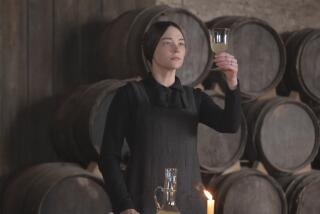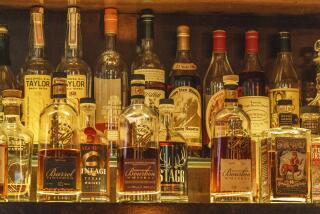In Haiti, a rum everyone can agree on
- Share via
Reporting from Port-Au-Prince, Haiti — When President Franklin Delano Roosevelt arrived here in 1934 to mark the end of America’s occupation of Haiti, he insisted on toasting the hand-over with local Barbancourt rum. Two decades later, the visiting Vice President Nixon personally mixed a Barbancourt rum collins for Haiti’s president (who was, ahem, a whiskey drinker).
And every voodoo priest and priestess in Haiti knows that soaking the ground with the golden rum -- not the three-star version, mind you, but the five-star, aged twice as long -- can raise the spirits of the dead.
FOR THE RECORD:
Haitian rum: A Feb. 9 article in Section A about Barbancourt rum said that white rum is made from the molasses byproduct of sugar production. It should have said that the vast majority of white rums are made that way. —
“It’s what they drink,” Markendy Jean Batiste, a voodoo priest, said with a shrug as if explaining the obvious. “You’ve got to keep the spirits happy.”
Since Haiti’s founding, its important institutions have had foreshortened lives: The presidential palace has been burned down twice and again lies in ruins. Thirty-two rulers have been toppled. One leader was thrown out, returned and was sent packing again. U.S. troops ran the country for nearly two decades, left, came back and left again.
Over the last century and a half, though, against considerable odds, one national institution has survived intact -- Rhum Barbancourt.
The earthquake that struck Haiti last month didn’t pass over the venerable distillery, planted amid thick palms and bougainvillea north of Port-au-Prince. Walls collapsed, machinery was damaged, and the plant’s 800 French oak vats, each holding 2,000 gallons of rum, swayed and tumbled into one another like dominoes. About a third of the rum splashed onto the ground.
But the maker of Haiti’s best-known export, founded by Dupre Barbancourt in 1862 and controlled today by his heirs, is an institution that isn’t likely to disappear any time soon.
“There’s a lot of work to do, and we lost a lot of rum,” said Thierry Gardere, the silver-haired 57-year-old who presides over the company founded by his great-great uncle. “But we should be back in production in three or four months” -- a small interruption, though one Gardere says is unprecedented in Barbancourt’s history.
Beyond the distillery itself, the quake took a toll on the staff. Four of the plant’s 250 employees died in their homes, and one-fifth of them are homeless. The company opened its soccer field to homeless residents of the neighborhood, and its employees are among the 1,400 now camped there. Gardere’s own house, in a ritzy part of the capital’s Petionville area, was destroyed. For days, rescue helicopters used his garden to evacuate the injured from the Hotel Montana across the street.
But Barbancourt’s survivors were back on the job last week, rebuilding walls and moving rum out of damaged barrels. Gardere was leading a team of insurance adjusters, wearing orange vests and carrying cameras, through the plant. Export orders were being filled from Barbancourt’s downtown warehouse, which didn’t lose a single bottle.
On the wall of the air-conditioned reception area was a reminder of a glorious past, knocked askew by the quake’s force: a framed oval display of medals from 19th century tastings in Paris, London, Rouen and Amsterdam.
“This has been a shock for Mr. Gardere and all of us here,” said William Eliacin, the company’s financial director.
Dupre Barbancourt, a native of the Cognac region of France, opened the distillery to make rum from the sugar cane introduced to the island by Christopher Columbus.
Unlike white rum, which is made from the molasses byproduct of sugar production, Barbancourt made his rum from the sugar cane juice itself. He used a double distillation process, favored by Cognac makers, and aged the rum in French oak barrels imported from Limousin. Three of those original deep mahogany-stained barrels are still on display in the plant’s lobby.
Last year, Barbancourt produced 3 million liters -- nearly 800,000 gallons -- of rum, about half of which was sent abroad. During a trade embargo imposed in 1991 to pressure a junta to relinquish power, exports to the United States dried up. But after the U.S military arrived in 1994 to reinstall President Jean-Bertrand Aristide, the embargo was lifted.
Rum exports to the United States quickly recovered and U.S. sales have nearly doubled over the last decade, to 20,000 cases a year, making it the company’s largest foreign market.
Barbancourt has annual sales of $12 million, Gardere said. About 60% comes from the three-star rum, which is aged four years and sells locally for about $4.50 per liter bottle. A third comes from the five-star rum, which is aged eight years and costs about $13 locally. A small percentage, less than 2%, is from the $35 reserve rum, aged 15 years.
The largest part of the company’s sales gains in the last five years have been in Haiti. “People have had a little bit more money, and now they’re looking for the brand, looking for quality,” Gardere said. “I’m not sure that will remain, though.”
Henry Kenol’s luxury pickup bounced down narrow dirt roads, tunneling through thick, 10-foot-tall fields of sugar cane, on a mission to calm some of the 4,000 independent farmers who grow 80% of the cane that Barbancourt uses.
Kenol, 43, Barbancourt’s supply director, asked farmers to suspend the harvest until the plant could resume distilling operations. To guarantee the highest sugar content, the cane needs to be harvested sometime between eight and 12 months maturity.
Much of the crop is approaching 10 months maturity, and the farmers are getting antsy.
He stopped and rolled down the window to talk to Adilise Selistan, a 76-year-old in a floppy hat, eyes hidden behind sunglasses, who was sitting on an emaciated gray horse. “When can we cut again?” asked Selistan, the patriarch of a family that owns several dozen acres.
“Real soon,” Kenol promised. “We have a lot of work to do, and our engineers are putting the machinery back together. But don’t worry. Two weeks or a month at most.”
Selistan seemed to be appeased, for now. After all, his contract with Barbancourt is lucrative -- it pays $20 a ton for sugar cane, higher than the price growers can get elsewhere. “All my cane is for Barbancourt,” he said. “And, no matter what happens, Barbancourt will never be destroyed.”
“Just be patient,” Kenol said.
The secret to Barbancourt’s survival in the face of Haiti’s tumultuous history, Gardere believes, is its steadfast resistance to change. Back in the 1950s, the family sued a distant relative who had opened a tasting room, offering flavored rums, under the Barbancourt name. The Garderes won the suit.
“Our goal has always been to keep the traditions going,” Gardere said.
Another reason is the sense of loyalty Haitians have for their national drink and the special place it holds in important rituals, from weddings and holidays to bringing forth the voodoo spirits that appease the dead and protect the living.
Each of the spirits has a favorite beverage. For some it’s moonshine, for others Champagne. But for several important spirits, it’s five-star Barbancourt. Nothing else will do. Empty Barbancourt bottles litter the cemeteries of Port-au-Prince.
The drinking habits of the dead are something “we have no control over, obviously,” Eliacin, the finance director, said, smiling. “But you must understand that Barbancourt doesn’t belong to us. It belongs to the Haitian people.”
Like many of his fellow Haitians, Gardere hopes the country will find a way to look to the future and build a better nation.
“We hope,” he said, “that we can all start in a new place.”
As for Rhum Barbancourt’s future, Gardere says a succession plan is already in the works. His 26-year-old daughter, Delphine, has been studying marketing in Britain. Keeping Barbancourt around for a fifth generation is not just a matter of family pride -- it’s a national obligation.
More to Read
Sign up for The Wild
We’ll help you find the best places to hike, bike and run, as well as the perfect silent spots for meditation and yoga.
You may occasionally receive promotional content from the Los Angeles Times.







